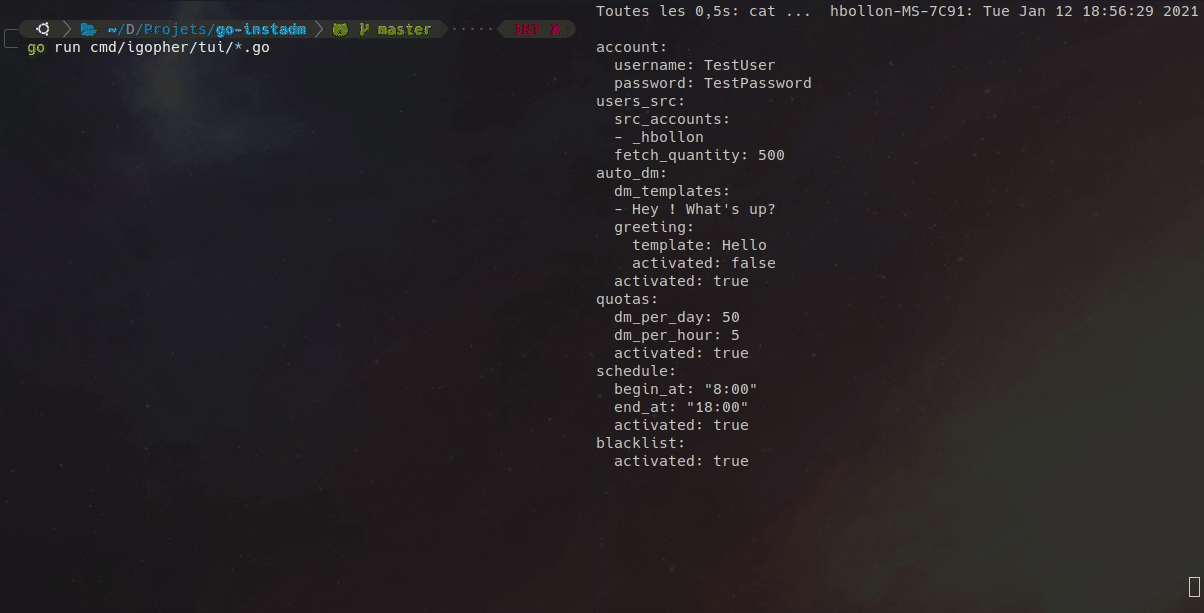⚡ Powerful, customizable and easy to use Instagram dm bot. With TUI and GUI! Using Selenium webdriver and Yaml configuration files.
Disclaimer: This is a research project. I am in no way responsible for the use you made of this tool. In addition, I am not responsible for any sanctions and/or limitations imposed on your account after using this bot.
IGopher is a new Instagram automation tool that aims to simplify the deployment of such tools and make their use more pleasant thanks to a TUI (terminal User Interface) as well as a GUI (Graphical User Interface) arriving very soon.
 Automatic user fetching and message sending!
Automatic user fetching and message sending!
The bot configuration is very easy thanks to the different configuration menus in the TUI. Parameters are managed and saved in Yaml files easy to edit manually!
 Easily configurable and easy to use thanks to his TUI !
Easily configurable and easy to use thanks to his TUI !
- Java
- For Windows:
- [Optionnal] Windows Terminal -> in order to have a best TUI experience
- Selenium webdriver engine 🌠
- Automatic dependencies downloading and installation 🌠
- Automated IG connection & message sending 🌠
- Users scrapping from ig user followers 🌠
- Scheduler 🌠
- Quotas & user blacklist modules 🌠
- Human writing simulation 🌠
- Fully and easily customizable through Yaml files or with TUI 🌠
- TUI (Terminal User Interface) 🌠
- Many more to come ! 🥳
Check this Project to see all planned features for this tool! Feel free to suggest additional features to implement! 🥳
- Download and install Java and Java JDK (needed for Selenium webdriver) and add them to your path (on Windows)
- Download lastest release executable for your operating system
- Move the executable to a dedicated folder (it will create folders/files)
- Launch it:
- On Windows, open a Windows Terminal in the folder (or powershell/cmd but the experience quality can be lower) and execute it:
./tui.exeor just drag and drop tui.exe in your command prompt - On Linux or MacOS, open you favorite shell in the folder, allow it to be executed with
chmod +x ./tuiand launch it:./tui
- Configure the bot with your Instagram credentials and set your desired scrapping and autodm settings. To do that, you can use the TUI settings screen or directly edit the config.yaml file.
- You're ready! Just hit the "Launch" option in the TUI main menu 🚀
- Download and install Java and Java JDK (needed for Selenium webdriver) and add them to your path (on Windows)
- Install Go (v1.13+) on your system
- Download lastest release source archive or clone the master branch
- Launch it with this command:
go run ./cmd/igopher/tui - Configure the bot with your Instagram credentials and set your desired scrapping and autodm settings. To do that, you can use the TUI settings screen or directly edit the config.yaml file.
- You're ready! Just hit the "Launch" option in the TUI main menu 🚀
IGopher have a flags system for debuging or to enable system feature.
You can activate them by adding them after the executable call, for exemple to activate headless mode:
./tui --headless
There is the list of all available flags:
--debug
Display debug and selenium output
--force-download
Force redownload of all dependencies even if exists
--headless
Run WebDriver with frame buffer
--ignore-dependencies
Skip dependencies management
--loglevel string
Log level threshold (default "info")
--port int
Specify custom communication port (default 8080)
You can recover this list by adding --help flag.
Contributions are greatly appreciated!
- Fork the project
- Create your feature branch (
git checkout -b feature/AmazingFeature) - Commit your changes (
git commit -m 'Add some amazing stuff') - Push to the branch (
git push origin feature/AmazingFeature) - Create a new Pull Request
Issues and feature requests are welcome! Feel free to check issues page.
👤 Hugo Bollon
- Github: @hbollon
- LinkedIn: @Hugo Bollon
- Portfolio: hugobollon.me
Give a ⭐️ if this project helped you!
This project is under MIT license.

